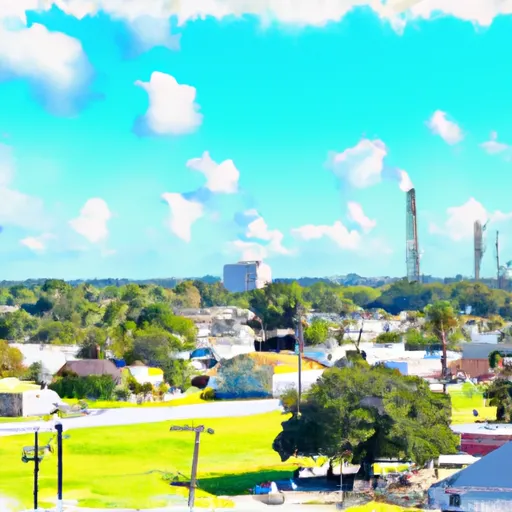-
 Snoflo Premium
Snoflo Premium
Get unlimited access to all our content
With no Ad interruptions! - Start Your Free Trial Login with existing account
Labelle
Eden Index
Climate
6.4
•
Recreation
4.8
•
Community
1.5
•
Safeguard
4.6/10

Labelle is a small rural town located in Hendry County, Florida. The town experiences a subtropical climate, characterized by hot and humid summers and mild winters. Summers are long and rainy, with average temperatures ranging from the mid-80s to low 90s Fahrenheit. Winters are drier and milder, with average temperatures in the mid-60s to low 70s Fahrenheit. Labelle's climate makes it an ideal destination for outdoor enthusiasts.
The town is situated near the Caloosahatchee River, which contributes to its hydrology constituents. The river provides opportunities for activities like fishing, boating, and kayaking. The river's diverse ecosystem supports a variety of wildlife, including exotic birds, manatees, and alligators.
For outdoor recreation, Labelle offers several parks and natural areas. The Port LaBelle Marina offers boat rentals and access to the river, while the Caloosahatchee Regional Park provides hiking and biking trails, picnic areas, and camping sites. Visitors can also explore the nearby Okaloacoochee Slough State Forest, which offers opportunities for birdwatching, hiking, and wildlife viewing.
Overall, Labelle's climate, hydrology constituents, and outdoor recreation opportunities make it a desirable destination for those seeking to experience Florida's natural beauty.
What is the Eden Index?
The Snoflo Eden Index serves as a comprehensive rating system for regions, evaluating their desirability through a holistic assessment of climate health, outdoor recreation opportunities, and natural disaster risk, acknowledging the profound impact of these factors on livability and well-being.
Climate Health Indicator (CHI): 6.4
Labelle receives approximately
1357mm of rain per year,
with humidity levels near 82%
and air temperatures averaging around
23°C.
Labelle has a plant hardyness factor of
9, meaning
plants and agriculture in this region tend to thrive here all year round.
By considering the ideal temperature range, reliable water supplies, clean air, and stable seasonal rain or snowpacks, the Climate Health Indicator (CHI) underscores the significance of a healthy climate as the foundation for quality living.
A healthy climate is paramount for ensuring a high quality of life and livability in a region, fostering both physical well-being and environmental harmony. This can be characterized by ideal temperatures, reliable access to water supplies, clean air, and consistent seasonal rain or snowpacks.
Weather Forecast
Streamflow Conditions
Southern Florida
Area Rivers
Southern Florida
Snowpack Depths
Southern Florida
Reservoir Storage Capacity
Southern Florida
Groundwater Levels
Recreational Opportunity Index (ROI): 4.8
The Recreational Opportunity Index (ROI) recognizes the value of outdoor recreational options, such as parks, hiking trails, camping sites, and fishing spots, while acknowledging that climate plays a pivotal role in ensuring the comfort and consistency of these experiences.
Access to outdoor recreational opportunities, encompassing activities such as parks, hiking, camping, and fishing, is crucial for overall well-being, and the climate plays a pivotal role in enabling and enhancing these experiences, ensuring that individuals can engage in nature-based activities comfortably and consistently.
Camping Areas
| Campground | Campsites | Reservations | Toilets | Showers | Elevation |
|---|---|---|---|---|---|
| Collier - Seminole State Park | None | 7 ft | |||
| Lake Kissimmee State Park | None | 70 ft | |||
| Arbuckle - Lake Wales Ridge SF | None | 87 ft | |||
| Avon Park AF Range Military | 40 | 71 ft | |||
| Highlands Hammock State Park | None | 136 ft | |||
| Burns Lake - Big Cypress National Preserve | 14 | 9 ft | |||
| Lake Arbuckle Co Park | 30 | 62 ft | |||
| Ortona South | None | 16 ft | |||
| Bear Island - Big Cypress WMA | None | 44 ft | |||
| Fisheating Creek Campground | 120 | 55 ft |
Nearby Ski Areas
Catastrophe Safeguard Index (CSI):
The Catastrophe Safeguard Index (CSI) recognizes that natural disaster risk, encompassing floods, fires, hurricanes, and tornadoes, can drastically affect safety and the overall appeal of an area.
The level of natural disaster risk in a region significantly affects safety and the overall livability, with climate change amplifying these risks by potentially increasing the frequency and intensity of events like floods, fires, hurricanes, and tornadoes, thereby posing substantial challenges to community resilience and well-being.
Community Resilience Indicator (CRI): 1.5
The Community Resilience Indicator (CRI) recognizes that education, healthcare, and socioeconomics are crucial to the well-being of a region. The CRI acknowledges the profound impact of these elements on residents' overall quality of life. By evaluating educational resources, healthcare accessibility, and economic inclusivity, the index captures the essential aspects that contribute to a thriving community, fostering resident satisfaction, equity, and social cohesion.

